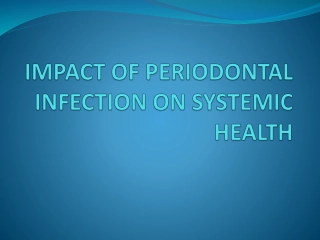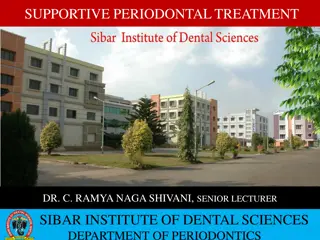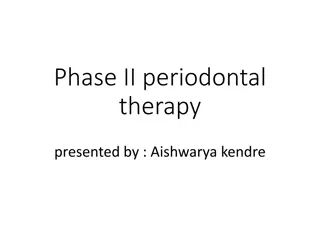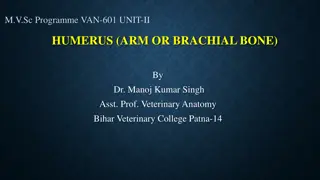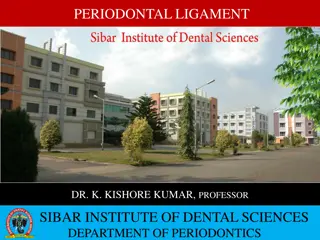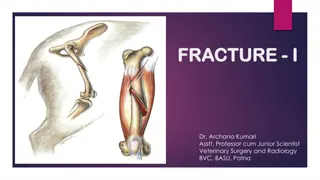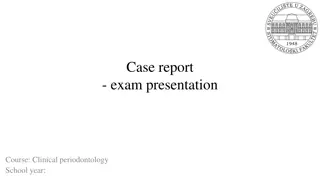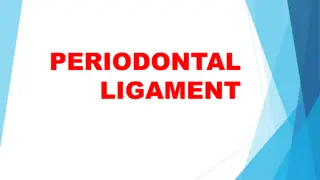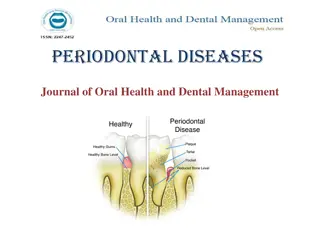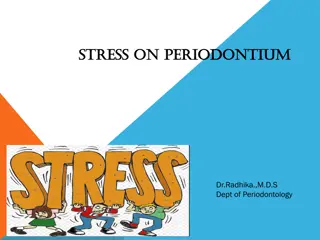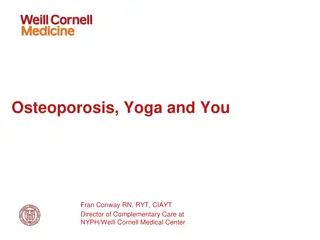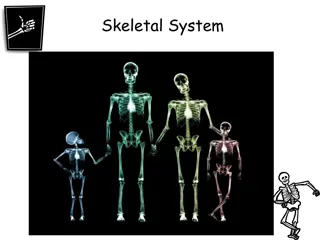Understanding Bone Destruction in Periodontal Disease
The progression of periodontal disease can lead to bone destruction in the alveolar bone, which is crucial in supporting teeth. The inflammatory process causes permanent damage to the periodontium tissues, resulting in connective tissue loss and bone resorption. Different patterns of bone loss, such as horizontal and vertical, can occur, affecting the height of the alveolar bone. Pathways of inflammation into the bone explain how the disease spreads within the gingiva, connective tissue, and periodontal ligament space, ultimately leading to bone destruction. Recognizing these mechanisms is vital in preventing tooth loss associated with periodontitis.
Download Presentation

Please find below an Image/Link to download the presentation.
The content on the website is provided AS IS for your information and personal use only. It may not be sold, licensed, or shared on other websites without obtaining consent from the author. Download presentation by click this link. If you encounter any issues during the download, it is possible that the publisher has removed the file from their server.
E N D
Presentation Transcript
. Defense Mechanisms of the Gingiva BONE DESTRUCTION & PERIODONTAL POCKET
PATHOGENESIS OF BONE DESTRUCTION The inflammatory process that occurs in periodontitis results in permanent destruction to the tissues of the periodontium, including connective tissue, periodontal ligament, & alveolar bone. the destruction gingival The pattern of bone destructions that occurs depends on the pathway of inflammation as it spreads from the gingiva into the alveolar bone. It is important to understand the changes that occur in the alveolar bone because it is the reduction in bone height that eventually results in tooth loss.
CHANGES IN ALVEOLAR BONE HEIGHT IN DISEASE: 1. Reduction in Bone Height A. in health and gingivitis the crest of the alveolar bone is located approximately 2 mm apical to (below) the CEJs of the teeth. B. in periodontitis bone destruction may be marked as periodontal disease progresses
PATTERNS OF BONE LOSS IN PERIODONTAL DISEASE Horizontal bone loss. 1-is the most common pattern of bone loss. results in a fairly even, overall reduction in the height of the alveolar bone . 2. This type of bone loss produces a suprabony pocket. * Vertical Bone Loss: is a less common pattern of bone loss. This type of bone loss results in an uneven reduction in the height of the alveolar bone, with bone resorption progressing more rapidly in the bone next to the root surface . vertical bone loss is also known as angular bone loss. 2. This uneven pattern of bone loss leaves a trench like area of missing bone alongside the root. 3. This type of bone loss produces an infrabony pocket.
PATHWAYS OF INFLAMMATIONS INTO BONE Horizontal Bone Loss A. (i) within the gingival connective tissue along the connective tissue sheaths surrounding the blood vessels, (ii) into the alveolar bone. (iii) finally, into the periodontal ligament space. B. The periodontal ligament fiber bundles act as an effective barrier to the spread of inflammation. Thus, the inflammation spreads into the alveolar bone and then into periodontal ligament space.
Vertical Bone Loss (i) within the gingival connective tissue, (ii) directly into periodontal ligament space. (iii) finally, into the alveolar bone . B. inflammation spreads in this manner whenever the crestal periodontal ligament fiber bundles are weakened and no longer present an effective barrier . prior events such as occlusal trauma can be responsible for the weakened condition of fiber bundles.
PERIODONTAL POCKETS Attachment Loss in periodontal pockets: A_Attachment loss: Is the destruction of the fibers and bone that support the teeth. B. Tissues destruction does not spread only in an apical (vertical) direction but also in a lateral (side-to-side) direction. C. A pocket on different root surface of the same tooth can have different depths.
A disease site: Is an area of tissue destruction. A disease site involves only a single surface of the tooth,. The disease site may involve several surfaces of the tooth or all four surfaces A . Inactive disease site a disease site that is stable, with attachment level of the junctional epithelium remaining the same over time . B . Active disease site a disease site that shows continued apical migration of thejunctional epithelium over time .
TYPES OF POCKETS 1.Gingival Pockets.: is a deepening of gingival sulcus as a result gingival enlargement. A. Also known as a pseudopocket, meaning a false pocket , because there is no destruction of the periodontal ligament fibers or alveolar bone in gingival pocket . B. There is no apical migration of a JE in a gingival pocket . . C.The increased probing depth is due to (i) swelling of the tissue or (ii) enlargement due to increase collagen fibers in the connective tissue .
2. Periodontal pockets: A periodontal pocket is a pathologic deepening of the gingival sulcus as the result of the: Apical migration of the juctional epithelium. Destruction of the periodontal ligament fibers. Destruction of alveolar bone. B. There are two types of periodontal pockets. The type of periodontal pocket is determined based on the relationship of the junctional epithelium to the crest of the alveolar bone.
1. suprabony Pocket: a. Suprabony Pocket occurs when there is horizontal bone loss (even loss of bone). b. The JE forming the base of the pocket, is located coronal to(above) the crest of the alveolar bone the base of the pocket is located within cratered out area of the bone alongside of the root surface . 2. Infrabony Pocket : a. Infrabony pockets occur when there is vertical bone loss ( uneven loss of bone). b. The JE, forming the base of the pocket, is located apical to ( below ) the crest of the alveolar bone.


